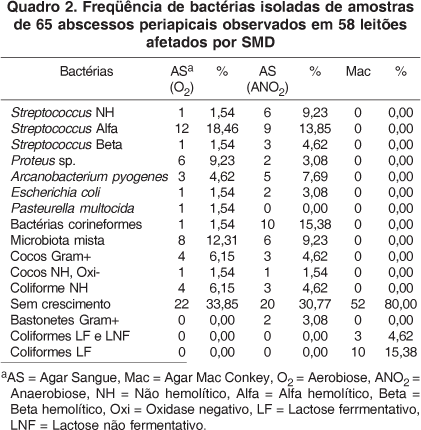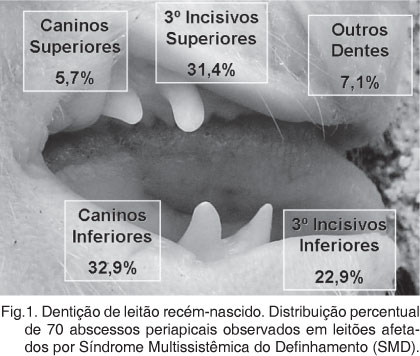Swine producers have historically resected needle teeth of newborn pigs to prevent potential injuries to the sow mammary gland and faces of littermates. However, the possible impact of this practice on pig performance has been questioned. As part of a study, 280 PMWS affected piglets, with 40-70 days of age, were examined for the presence of dental lesions immediately after euthanasia. Most pigs were confirmed as PMWS by the detection of typical microscopic lesions and immunohistochemical pattern. At least one periapical abscess was observed in 58 piglets (20.7%), of which 12 had multiple abscesses. There were 22 (31.4%), 16 (22.9%), 4 (5.7%), 23 (32.9%), and 5 (7.1%) abscesses in 3rd upper incisives, 3rd lower incisives, upper canines, lower canines, and other teeth, respectively. The higher prevalence of dental abscesses observed in 3rd incisives and lower canines is probably associated with the wider area of grinding or clipping to which these teeth were subjected. Among bacteria isolated from samples collected from 65 abscesses, Streptococcus sp. was the most prevalent bacteria and was present in 21.48% and 27.7% of the aerobic and anaerobic isolates, respectively. In the second most frequent group were coryneform microorganisms, which showed higher rate of isolation under anaerobic atmosphere than in aerobic culture. There was preponderance of Gram-positive isolates. It could not be determined whether these bacterial co-infections predisposed pigs to development of PMWS-type lesions or if were subsequent to the PCV2 infection.
Periapical abscess; causal bacteria; co-infection; PMWS; piglet; teeth resection; teeth clipping



